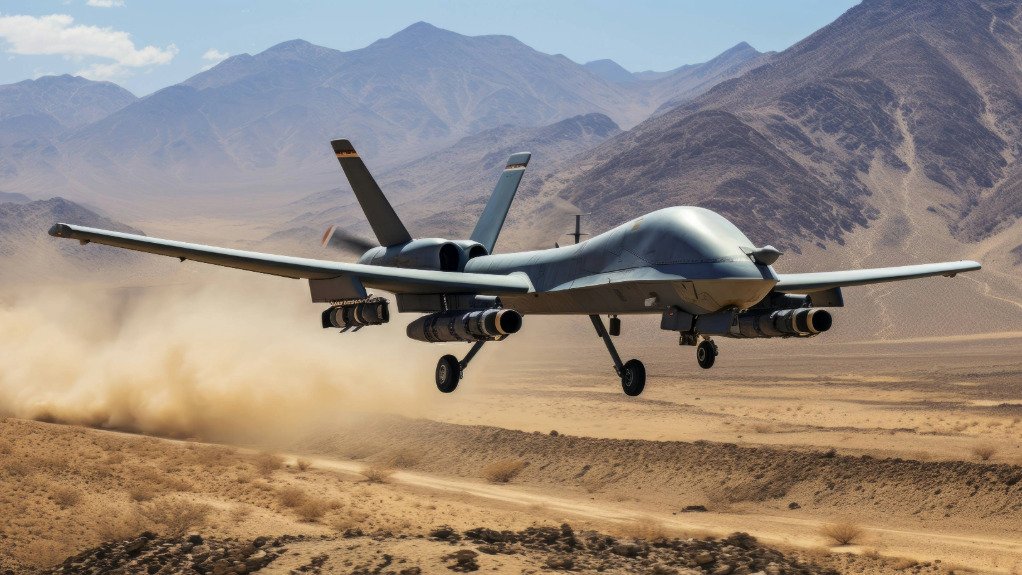Terrorist-controlled drones in Africa pose real and present threat
Unmanned aerial vehicles (UAVs) are rapidly becoming a key part of insurgent arsenals across the African continent, Stellenbosch University faculty of arts and social science vice dean of research Professor Lindy Heinecken has warned.
Speaking at the African Aerospace and Defence (AAD) trade show and exhibition at Air Force Base Waterkloof, in Centurion, on September 18, Heinecken highlighted the growing threat posed by the proliferation and misuse of UAVs by terrorist groups in Africa.
“We see rebels in Mozambique and Cabo Delgado using these to track troop movements and potentially attack targets. Insurgents in the Democratic Republic of the Congo (DRC) and Al-Shabaab fighters in Somalia are using drones for reconnaissance and tracking potential targets,” she mentioned.
Heinecken emphasised that UAVs, which have become more affordable and widely available, are no longer weapons controlled exclusively by States.
“Anybody can weaponise a drone. They can be used by individuals and groups with malicious intent. Drones can be equipped with various weapons that can carry explosive, chemical or biological payloads, making them a significant threat,” she explained.
In terms of national security, Heinecken pointed out the dual impact of UAVs. On the one hand, drones enhance surveillance capabilities, allowing for 24-hour monitoring of sensitive military and government installations.
“Drones are equipped with high-resolution cameras that can capture detailed images and videos from the air. Foreign powers can gather intelligence on sensitive sites almost continuously,” she noted.
However, she warned that such surveillance raises concerns about transparency and accountability, leading to significant pushback, especially if overused.
“Surveillance of one’s own territory, while it can prevent terrorist and enemy attacks, also creates significant backlash. Citizens, particularly in democratic societies, do not want to be subject to constant surveillance. It fosters distrust and suspicion,” Heinecken said.
She warned of the vulnerability of UAVs to cyberattacks, a key vulnerability despite leaps forward in cybersecurity measures.
“A key weakness of drones is that they can be hacked and controlled remotely, leading to misuse and sabotage. Hackers can hijack drones, redirecting them to unintended targets or disabling their functioning, thereby disrupting surveillance missions, intelligence gathering, military strikes and operations,” she stated.
Despite these risks, Heinecken acknowledged that UAVs, when used for legitimate purposes, can reduce casualties and are more cost-effective than other means of combat and surveillance.
“They are very effective weapons and are becoming the weapon of choice for armed forces, specifically because they can protect those boots on the ground, or eliminate the need for them altogether,” she explained.
Heinecken also described the rise of UAVs as a phenomenon of “liquid warfare”, where traditional control over airspace and defence is challenged.
“We don’t know where these drones are coming from. They can come at any time, at any place, at incredibly high speeds, and you have no control. You may have air defences, but you don’t know where they will come in. It represents a phenomenal change in the nature of warfare,” she said.
While UAVs offer operational advantages, Heinecken cautioned that their use can also fuel resentment and extremism.
“The overuse of drones has led to an erosion of trust and cohesion, perpetuating a cycle of violence and further proliferating the use of drone technology,” she said.
She raised a particular point of concern around the use of AI-directed targeting, where kill orders are largely coordinated and recommended through advanced AI algorithms rather than human decision-making.
“How it is evolving is bloody scary. We are in a position unlike before. There is a desensitisation from the remote nature of drone warfare, which can create a sense of distance between the decision-makers and the human cost of the actions.
“The information to decide on a drone strike is informed by AI and algorithms made by a bureaucratic kill chain. This abstraction makes it easier to justify the use of force without fully considering the potential consequences,” she said.
Heinecken noted that, while there is currently still a human behind these weapon systems, whether humans will continue to control this technology as it evolves, and who will be in control, remains “very concerning”.
She also raised the potential threat of drone swarms.
“There are many Air Force members in front of me. Your air defence systems would not be able to cope with large drone swarms. This is not science fiction. We saw the swarming of drones at the Beijing Olympics, for example, and in many other events, where as many as 6 000 drones were flown and operated by just four people on the ground. [Weaponising] these drones becomes really, really problematic,” she warned.
She noted that the potential and simultaneous threat of UAVs has created an arms race not dissimilar to the nuclear arms race.
“Stopping this is going to take a global commitment, like the ban on nuclear weapons. While there are high-level international debates on this matter among the superpowers, especially the US, the UK, Russia and China, they have not moved toward an agreement to ban autonomous weapons,” Heinecken noted.
Article Enquiry
Email Article
Save Article
Feedback
To advertise email advertising@creamermedia.co.za or click here
Comments
Announcements
What's On
Subscribe to improve your user experience...
Option 1 (equivalent of R125 a month):
Receive a weekly copy of Creamer Media's Engineering News & Mining Weekly magazine
(print copy for those in South Africa and e-magazine for those outside of South Africa)
Receive daily email newsletters
Access to full search results
Access archive of magazine back copies
Access to Projects in Progress
Access to ONE Research Report of your choice in PDF format
Option 2 (equivalent of R375 a month):
All benefits from Option 1
PLUS
Access to Creamer Media's Research Channel Africa for ALL Research Reports, in PDF format, on various industrial and mining sectors
including Electricity; Water; Energy Transition; Hydrogen; Roads, Rail and Ports; Coal; Gold; Platinum; Battery Metals; etc.
Already a subscriber?
Forgotten your password?
Receive weekly copy of Creamer Media's Engineering News & Mining Weekly magazine (print copy for those in South Africa and e-magazine for those outside of South Africa)
➕
Recieve daily email newsletters
➕
Access to full search results
➕
Access archive of magazine back copies
➕
Access to Projects in Progress
➕
Access to ONE Research Report of your choice in PDF format
RESEARCH CHANNEL AFRICA
R4500 (equivalent of R375 a month)
SUBSCRIBEAll benefits from Option 1
➕
Access to Creamer Media's Research Channel Africa for ALL Research Reports on various industrial and mining sectors, in PDF format, including on:
Electricity
➕
Water
➕
Energy Transition
➕
Hydrogen
➕
Roads, Rail and Ports
➕
Coal
➕
Gold
➕
Platinum
➕
Battery Metals
➕
etc.
Receive all benefits from Option 1 or Option 2 delivered to numerous people at your company
➕
Multiple User names and Passwords for simultaneous log-ins
➕
Intranet integration access to all in your organisation

















